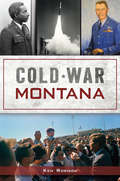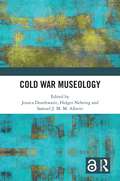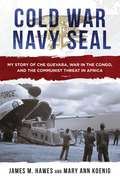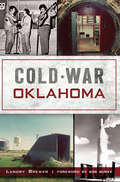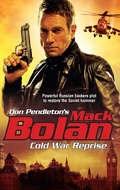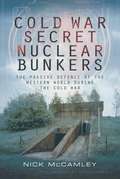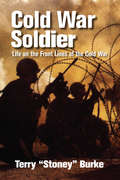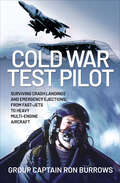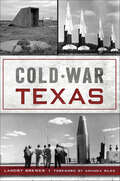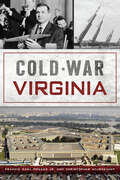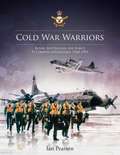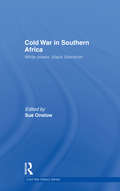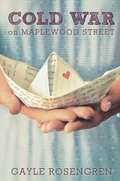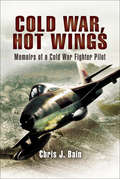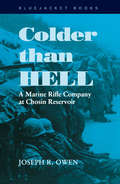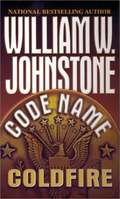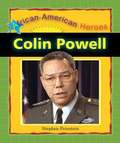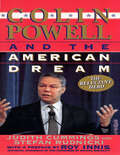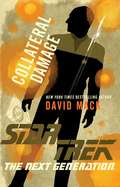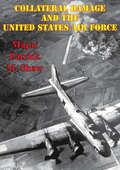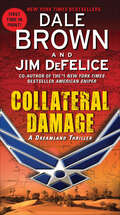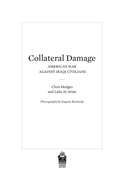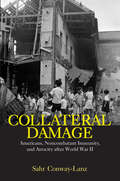- Table View
- List View
Cold War Montana (Military)
by Ken RobisonHome to some of the most powerful nuclear missile systems in the world, Montana played an indispensable role in the war against Communism. Utilizing the Lend-Lease pipeline, Soviet spies ferried stolen nuclear and industrial secrets, loaded in diplomatic pouches, from Great Falls to the Soviet Union. Army nurse Lieutenant Diane Carlson served as "an angel of mercy" at the Pleiku Evacuation Hospital in the Central Highlands in Vietnam. Young Montana smokejumper "Hog" Daniels joined the CIA's secret war in Southeast Asia, becoming the principal advisor to General Vang Pao in his desperate fight against Communists. Captain Ken Robison (U.S. Navy, Ret.), award-winning author and Cold Warrior, reveals tales of Montanans who made their mark on this titanic struggle.
Cold War Museology
by Peter Robinson Adam R. Seipp Holger Nehring Grace Huxford Cecilia Åse Maria Wendt Mattias Frihammar Peter Johnston Rosanna Farbøl Jessica Douthwaite Alberti, Samuel J. M. M. Fredrik Krohn Andersson Ulla Varnke Sand Egeskov Bodil Frandsen Jim Gledhill Johannes-Geert Hagmann Sarah A. Harper Milka Ivanova Karl L. KleveCold War Museology is the first volume to bring together interdisciplinary and international contributions from leading practitioners and academics specialising in Cold War museology. Bringing the most recent historiography of the Cold War into conversation with museological theory and practice, chapters within the volume analyse the current condition of Cold War museology. By unpicking some of the unique challenges facing museum specialists dealing with the Cold War, this book takes a lead in developing the collection, display and interpretation of this history. The chapters question what makes a Cold War object; address the complexity of Cold War time; face up to questions of Cold War race, gender and imperialism; and reveal how to materialise the Cold War imaginary in museums. Most importantly perhaps, the volume demonstrates that, a consideration of the interconnecting forces of global twentieth-century history enables experts to add important complexity and nuance to the narratives with which they work and improve visitor understandings through innovative interpretations.Cold War Museology will encourage readers towards a more nuanced, holistic and inclusive approach to Cold War materiality in museums. It will be of great interest to academics, museum professionals and students engaged in the study of museums, heritage and the Cold War, as well as those with an interest in archaeology, media, culture and memory.
Cold War Navy SEAL: My Story of Che Guevara, War in the Congo, and the Communist Threat in Africa
by James M. Hawes Mary Ann KoenigFor the first time, a Navy SEAL tells the story of the US's clandestine operations in North Vietnam and the Congo during the Cold War. Sometime in 1965, James Hawes landed in the Congo with cash stuffed in his socks, morphine in his bag, and a basic understanding of his mission: recruit a mercenary navy and suppress the Soviet- and Chinese-backed rebels engaged in guerilla movements against a pro-Western government. He knew the United States must preserve deniability, so he would be abandoned in any life-threatening situation; he did not know that Che Guevara attempting to export his revolution a few miles away. Cold War Navy SEAL gives unprecedented insight into a clandestine chapter in US history through the experiences of Hawes, a distinguished Navy frogman and later a CIA contractor. His journey began as an officer in the newly-formed SEAL Team 2, which then led him to Vietnam in 1964 to train hit-and-run boat teams who ran clandestine raids into North Vietnam. Those raids directly instigated the Gulf of Tonkin Incident. The CIA tapped Hawes to deploy to the Congo, where he would be tasked with creating and leading a paramilitary navy on Lake Tanganyika to disrupt guerilla action in the country. According to the US government, he did not, and could not, exist; he was on his own, 1400 miles from his closest allies, with only periodic letters via air-drop as communication. Hawes recalls recruiting and managing some of the most dangerous mercenaries in Africa, battling rebels with a crew of anti-Castro Cuban exiles, and learning what the rest of the intelligence world was dying to know: the location of Che Guevara. In vivid detail that rivals any action movie, Hawes describes how he and his team discovered Guevara leading the communist rebels on the other side and eventually forced him from the country, accomplishing a seemingly impossible mission. Complete with never-before-seen photographs and interviews with fellow operatives in the Congo, Cold War Navy SEAL is an unblinking look at a portion of Cold War history never before told.
Cold War Oklahoma
by Landry BrewerOklahoma might seem like an unexpected place for Cold War tensions to boil over, but the state played a key role in a conflict that threatened global annihilation. Altus Air Force Base served as a hub for twelve intercontinental ballistic missile launch sites; in 1964, a missile housed at the Frederick site exploded, although the nuclear warhead remained unaffected. Ordinary citizens lived under the shadow of nuclear war as well. A former OU faculty member accused of committing espionage for the Soviet Union fled the country, while a SWOSU professor dug his own fallout shelter in Weatherford--by hand. During the Cuban Missile Crisis, an emergency siren malfunction sent terrified Elk City parents scurrying to local schools to pick up their children. Landry Brewer presents a fascinating cross-section of the era, from top-level strategy to the details of daily life.
Cold War Reprise
by Don PendletonEarly in his blitz days, Mack Bolan singlehandedly shook the KGB to its core. Now intelligence puts him in a face-off with Spetsnaz soldiers revitalized as the new enforcement arm of old-guard Russia. At its helm, a secret consortium is determined to restore the terror tactics of the former Soviet Union, but bigger and bloodier than ever. Bolan's hunt begins in London, where he avenges the deaths of two Russian friends, but leads him deep into Moscow, where trained killers backed by money and power plan an explosive death knell to Russian freedom and millions of innocents. It's a repackaged enemy backed by old-school terror, a breed Bolan intends to take down once again with lethal force.
Cold War Secret Nuclear Bunkers: The Passive Defence of the Western World During the Cold War
by Nick McCamley&“Draws on previously classified documents to reveal the sums spent on underground shelters for British and American leaders during the Cold War.&” —Publishers Weekly Cold War Secret Nuclear Bunkers tells the previously undisclosed story of the secret defence structures built by the West during the Cold War years. Author Nick McCamley reveals the various bunkers built for the U.S. Administration, including the Raven Rock alternate war headquarters (the Pentagon&’s wartime hideout), the Greenbrier bunker for the Senate and House of Representatives, and the Mount Weather central government headquarter, as well as developments in Canadas and extensive coverage of the UK, including the London bunkers and Regional War rooms built in the 1950s to protect against Soviet threat. The book examines the provision, (or more accurately, lack of provision), of shelter space for the general population, comparing the situation in the USA and the UK with some other European countries and with the Soviet Union. McCamley also provides in fascinating detail the vast umbrella of radar stations that spanned the North American continent and the north Atlantic from the Aleutian Islands through Canada to the North Yorkshire moors, all centered upon an enormous secret control center buried hundreds of feet below Cheyenne Mountain in Colorado. This is complemented in the United Kingdom with a chain of secret radars codenamed &‘Rotor&’ built in the early 1950&’s, and eight huge, inland sector control centers, built over 100&’ underground at enormous cost. Also included is the UK Warning and Monitoring Organization with its underground bunkers and observation posts, as well as the little known bunkers built by the various local authorities and public utilities.
Cold War Soldier: Life on the Front Lines of the Cold War
by Terry Stoney" BurkeThe danger of participating in live-fire exercises and a Christmas spent in a military prison are described in detail in this graphic picture of military life at the height of the Cold War. "From Stettin in the Baltic to Trieste in the Adriatic, an ’iron curtain’ has descended across the continent." These words, uttered by Winston Churchill in 1946, heralded the beginning of the Cold War. In this first-hand account of a NATO soldier, Terry Stoney Burke paints a graphic picture of military life at the height of the Cold War. From the trials and tribulations of basic training, through his progress of becoming an infantryman and explosive specialist, to his posting in Germany, his pull no punches narrative tells the sometimes humorous, often poignant, story of life as a common soldier. Cold War Soldieris not a book for veterans alone. Burkes explanations of military procedures, weapons, and army life strike a happy balance between reminding ex-servicemen of things they knew but may have forgotten, and creating a clear picture for the military novice.
Cold War Test Pilot: Surviving Crash Landings and Emergency Ejections: From Fast-Jets to Heavy Multi-Engine Aircraft
by Ron BurrowsA chief test pilot recounts his hair-raising experiences with the RAF in this detailed and often-witty memoir. Includes photos. The Falkland Islands had been invaded and a Task Force was already steaming south at full speed. On board the carriers were the Harriers that would provide essential aerial cover for the British troops and ships sent to recapture the islands. They would be entering particularly hostile territory, and the type&’s capabilities urgently needed to be expanded and proved. This was a job that Ron Burrows and the test pilots of his elite Fighter Test Squadron at Boscombe Down were ready to take on. From the 1960s to the 1990s, Ron test-flew all the RAF&’s fast-jets—in the process of which he survived two crash landings and two emergency ejections, as well as numerous other close shaves. A master of his craft, he rose to become the Aeroplane and Armament Experimental Establishment&’s chief test pilot, and this is his remarkable story. With four test-flying tours under his belt and close-air-support missions flying Hunters in the Aden Emergency, Ron&’s experiences extended throughout the critical final decades of the Cold War. A graduate of the US Navy&’s test pilot school, he has flown an unusually broad range of US and UK aircraft from fast-jets to heavy multi-engine aircraft. With his unrivaled knowledge and expertise, he is able to explain the methods, techniques, and demands of his profession, with many examples of what can and often does go wrong in aircraft development and testing. His descriptions of his near misses and catastrophic accidents are written with color and candor. But he also tries to inform the reader about the skills required to fly and test fast-jets and about the development of cockpit displays and design, highlighting some of the issues and problems encountered in development and in operation. &“If it can go wrong, it will go wrong&” could be the subtitle of this frank and witty account which flies along with the speed of one of those fast-jets.
Cold War Texas
by Landry BrewerFrom missile launch sites to Soviet espionage, experience the Cold War deep in the heart of Texas.In an era when miscalculation or a mistake could lead to global annihilation, Texas operated 12 Atlas F intercontinental ballistic missile launch sites near Abilene's Dyess Air Force Base. Nuclear-capable Nike Hercules surface-to-air antiaircraft missiles protected Austin and the Metroplex from a Soviet bomber attack. An American pilot stationed at Laughlin Air Force Base near Del Rio was the only fatality of the Cuban Missile Crisis. After he was accused of spying for the Soviet Union, former Ranger College professor Maurice Halperin fled the country. Amarillo's Pantex plant, where three employees died in a 1977 explosion, maintains the security and reliability of the nation's nuclear weapons arsenal. Landry Brewer explores how the Lone Star State shaped American Cold War policy.
Cold War Virginia (Military)
by Christopher Sturdevant Francis Powers Jr.The Old Dominion's defense of democracy… The Commonwealth played a central role in United States involvement during the Cold War. With doomsday planning operations underway for World War III, the location of the Pentagon, CIA and other federal agencies established Northern Virginia as an epicenter of decision-making. As Virginia military bases readied for a potential surprise attack by the Soviet Union, local research facilities played a paramount role in the Space Race. In 1960, the Soviet Union's shoot-down of U-2 pilot Francis Gary Powers, a Virginia native, created a superpower crisis of epic proportions. Cold War historians Francis Gary Powers Jr. and Christopher Sturdevant tell these and other tales of espionage, heroism and betrayal.
Cold War Warriors: Royal Australian Air Force P-3 Orion Operations 1968-1991
by Ian PearsonCold War Warriors tells the little-known story of the operations by the Royal Australian Air Force&’s P-3 Orions during the latter years of the Cold War. The aircraft&’s largely low-profile missions, usually flown far from their base, were often shrouded by confidentiality. Now, access to declassified documents has allowed this story to be told. From the lead-up to their delivery in 1968, to the end of the Cold War in 1991; from the intrigues associated with the procurement of the aircraft and subsequent upgrades, to perilous moments experienced by the aircraft and their crews while conducting operations; and from triumphs to tragedies; Cold War Warriors documents the P-3&’s service in the RAAF in the context of the unfolding domestic and international events that shaped the aircraft&’s evolving missions. As well as being a story of the RAAF Orions and their growing capabilities, Cold War Warriors is also the story of the crews who flew the aircraft. Using their words, Cold War Warriors faithfully describes a number of incidents, both on the ground, and in the air, to provide a sense of the enormous breadth of service the P-3 Orion has provided to the Royal Australian Air Force, to Australia and to our allies.
Cold War Warriors: The Story of the Duke of Edinburgh's Royal Regiment (Berkshire and Wiltshire), 1959-1994
by David StoneWith over four years research, the author draws upon the regimental archives and journals, anecdotes, personal and official diaries, and a wide range of other documents and interviews. The book's recurring themes are the changing nature of infantry soldiering, the constant battle of the Army to recruit, and the traditions and the 'oneness' of an infantry regiment. Special emphasis and extensive coverage is also given to the 1st Battalion's operational activities and to the Northern Ireland campaign in particular.
Cold War Wisconsin
by Christopher SturdevantAs the Cold War gripped the world with fear of espionage and nuclear winter, everyday Wisconsinites found themselves embroiled in the struggle. For decades, the state's nuclear missiles pointed to the skies, awaiting Soviet bombers. Joseph Stalin's daughter sought refuge in the small town of Richland Center. With violence in Vietnam about to peak, a cargo ship from Kewaunee sparked a new international incident with North Korea. Manitowoc was ground zero for a Sputnik satellite crash, and four ordinary Madison youths landed on the FBI's most wanted list after the Sterling Hall Bombing. Local author and chairman of the Midwest Chapter of the Cold War Museum Chris Sturdevant shares the tales of the Badger State's role in this titanic showdown between East and West.
Cold War in Southern Africa: White Power, Black Liberation (Cold War History)
by Sue OnslowThis edited volume examines the complexities of the Cold War in Southern Africa and uses a range of archives to develop a more detailed understanding of the impact of the Cold War environment upon the processes of political change. In the aftermath of European decolonization, the struggle between white minority governments and black liberation movements encouraged both sides to appeal for external support from the two superpower blocs. Cold War in Southern Africa highlights the importance of the global ideological environment on the perceptions and consequent behaviour of the white minority regimes, the Black Nationalist movements, and the newly independent African nationalist governments. Together, they underline the variety of archival sources on the history of Southern Africa in the Cold War and its growing importance in Cold War Studies. This volume brings together a series of essays by leading scholars based on a wide range of sources in the United States, Russia, Cuba, Britain, Zambia and South Africa. By focussing on a range of independent actors, these essays highlight the complexity of the conflict in Southern Africa: a battle of power blocs, of systems and ideas, which intersected with notions and practices of race and class This book will appeal to students of cold war studies, US foreign policy, African politics and International History. Sue Onslow has taught at the London School of Economics since 1994. She is currently a Cold War Studies Fellow in the Cold War Studies Centre/IDEAS
Cold War on Maplewood Street
by Gayle RosengrenCold War anxieties play out in a sensitively told story set during the Cuban missile crisis in the 1960s, perfect for fans of Gary Schmidt and Kristin Levine. Joanna can't get over how her brother broke his promise to never leave like their dad did. Sam is thousands of miles away on a navy ship, and no matter how often he sends letters, Joanna refuses to write back. When she makes a promise, she keeps it.But then President Kennedy comes on TV with frightening news about Soviet missiles in Cuba--and that's where Sam's heading. Suddenly Joanna's worries about being home alone, building up the courage to talk to a cute boy, and not being allowed to go to the first boy-girl party in her grade don't seem so important. Maybe sometimes there are good reasons to break a promise.The tense timeline of the Cuban missile crisis unfolds alongside a powerful, and ultimately hopeful, story about what it means to grow up in a world full of uncertainty.
Cold War, Hot Wings: Memoirs of a Cold War Fighter Pilot, 1962–1994
by Chris J. BainThis is a semi-autobiographical account of a fighter pilot in the RAF from 1962 to 1994. He was both a Hunter and Harrier pilot, rose to Squadron Leader level, and commanded fighter and strategic reconnaissance units. He was CO of the Desert Rescue Team, flew Dakotas on desert supply running, and saw active fighter service receiving bullet holes in his aircraft during the Aden Radfan campaign. He flew Cold War covert reconnaissance missions, commanded the Harrier unit in Belize, spent the Gulf War working with the US Defense Intelligence Agency, and became a nuclear weapons specialist.The book includes inside accounts of army support missions on the Yemen border, flying cold war reconnaissance missions in Europe, early day conversion to Harriers without any training aids, and long range ultra-high-level, covert photo intelligence gathering sorties, including helping police and customs with airborne photography, most notably for the 2nd Moors Murder Inquiry. It also includes political, geographical and economic background of all the places in which he served, and comments on political and military decisions made at those times.
Colder than Hell
by Joseph R. OwenDuring the early, uncertain days of the Korean War, World War II veteran and company lieutenant Joe Owen saw firsthand how the hastily assembled mix of some two hundred regulars and raw reservists hardened into a superb Marine rifle company known as Baker-One-Seven.As comrades fell wounded and dead around them on the frozen slopes above Korea's infamous Chosin Reservoir, Baker-One-Seven's Marines triumphed against the relentless human-wave assaults of Chinese regulars and took part in the breakout that destroyed six to eight divisions of Chinese regulars. COLDER THAN HELL paints a vivid, frightening portrait of one of the most horrific infantry battles ever waged.
Coldfire (Code Name Series #4)
by William W. JohnstoneToday, when bomb-throwing madmen rule nations and crime cartels strangle the globe, justice demands extreme measures. For twenty years, ex-CIA agent John Barrone fought his country's dirty back-alley wars. Now, he spearheads a secret strike force of elite law enforcement and intelligence professionals on a seek-and-destroy mission against America's sworn enemies. CODE NAME COLDFIRE Someone has shipped a tactical nuclear device to the U.S.A. For John Barrone, the way to knock out the nuke is to go undercover into two deadly terrorist organizations. But when Barrone's best operators penetrate one force on the Far Right, and another on the Radical Left, the true terror is revealed. Now, a warhead hidden somewhere in the heartland of America is set to go off—and one strike force is all that stands in the way...
Colin Powell (African-American Heroes)
by Stephen FeinsteinColin Powell was the first African American to be Secretary of State, following an illustrious career as a four-star general and Chairman of the Joint Chiefs of Staff. This easy biography is deal for early independent readers and useful for beginning reports.
Colin Powell and the American Dream: The Reluctant Hero
by Stefan Rudnicki Judith CummingsEminent political figure Colin Powell was a model for our time. In addition to chronicling Powell's humble beginnings, this biography recounts his inspiring rise to become one of the most revered figures in contemporary America. This book also examines the former Secretary of State's ideology, military acumen, and family values as well as Powell's evolving thoughts on key political issues and his lasting effects on the nation.
Collateral Damage (Star Trek: The Next Generation)
by David MackFrom the New York Times bestselling author of Star Trek: Discovery: Desperate Hours comes an original, thrilling novel set in the universe of Star Trek: The Next Generation!The past returns to haunt Captain Jean-Luc Picard—a crime he thought long buried has been exposed, and he must return to Earth to answer for his role in a conspiracy that some call treason. Meanwhile, the U.S.S. Enterprise is sent to apprehend pirates who have stolen vital technology from a fragile Federation colony. But acting captain Commander Worf discovers that the pirates&’ motives are not what they seem, and that sometimes standing for justice means defying the law….
Collateral Damage And The United States Air Force
by Major Patrick M. ShawMinimization of collateral damage is an objective of the United States Air Force (USAF) whenever it conducts hostile operations. While the USAF has often expressed concern about causing collateral damage, its actions have not always reflected a consistent level of commitment. This essay explores the evolution of USAF concerns about collateral damage and examines the causes and effects of this unfortunate by-product of airpower. It concludes that the concerns harbored about causing collateral damage reduce the military effectiveness of airpower. This loss of effectiveness is not always important. For example, when a resource rich coalition conducts an air campaign against an inferior adversary, that coalition can discriminate in its application of airpower by allocating great effort to the avoidance of collateral damage. In a different context, such asymmetry may not exist. Commanders then might have to focus on achieving objectives while paying little attention to the possibility of collateral damage. In either case, collateral damage will likely occur, varying only in degree. The USAF can take actions which will help alleviate some of the causes of collateral damage. Improvements in the areas of planning and technology provide certain relief, but ultimately, political and military leaders must accept that collateral damage is an inevitable part of airpower.
Collateral Damage: A Dreamland Thriller (Dreamland Thrillers #14)
by Dale Brown Jim DeFeliceWhen a military drone goes rogue over the skies of Libya, Dreamland’s covert strike force must enter the fray in this international action thriller.The fires still burn in Libya years after the fall of Gaddafi, forcing NATO to intervene in a new war that could have devastating consequences for the volatile region. But something has gone terribly wrong with a foolproof new superweapon, resulting in the shocking deaths of innocents.The latest military miracle to come out of the Whiplash group was designed to eliminate any possibility of human error—yet the computer-controlled UAV drone inexplicably goes rogue while the whole world watches. With the entire Whiplash program under fire, the weapon’s creator heads into the warzone determined to find evidence of sabotage. But in the blistering heat of the conflict, an enemy is waiting for him, determined to unleash more chaos and terror and death. Now pilot Turk Mako must take to the skies once more to prove that a skilled ace can do what no computer can.
Collateral Damage: America's War Against Iraqi Civilians
by Hedges"Collateral Damage" brings together testimony from the largest number of on the record, named, combat veterans who reveal the disturbing, daily reality of war and occupation in Iraq. Through their eyes, we learn how the mechanics of war lead to the abuse and frequent killing of innocents. They describe convoys of vehicles roaring down roads, smashing into cars, and hitting Iraqi civilians. They detail raids that leave families shot dead in the mayhem. And they describe a battlefield in which troops, untrained to distinguish between combatants and civilians, are authorized to shoot whenever they feel threatened.
Collateral Damage: Americans, Noncombatant Immunity, and Atrocity after World War II
by Sahr Conway-Lanz"Collateral damage" is a military term for the inadvertent casualties and destruction inflicted on civilians in the course of military operations. In Collateral Damage: Americans, Noncombatant Immunity, and Atrocity after World War II, Sahr Conway-Lanz chronicles the history of America's attempt to reconcile the ideal of sparing civilians with the reality that modern warfare results in the killing of innocent people. Drawing on policymakers' response to the issues raised by the atrocities of World War II and the use of the atomic bomb, as well as the ongoing debate by the American public and the media as the Korean War developed, Conway-Lanz provides a comprehensive examination of modern American discourse on the topic of civilian casualties and provides a fascinating look at the development of what is now commonly known as collateral damage.
